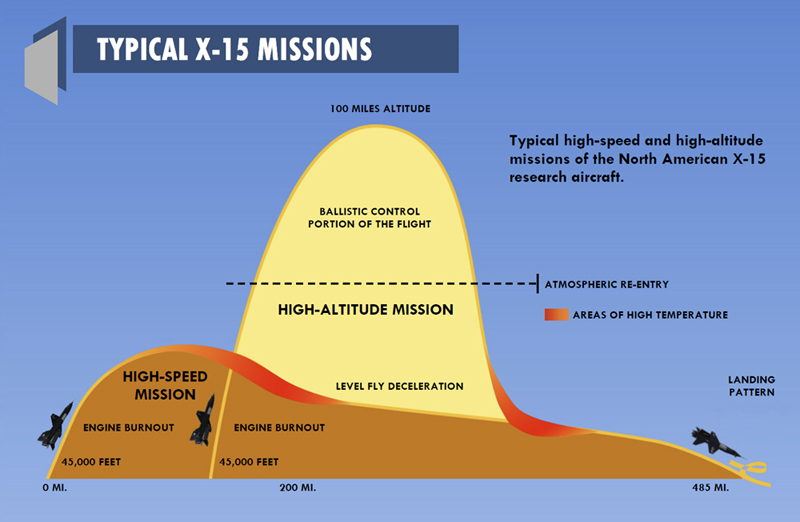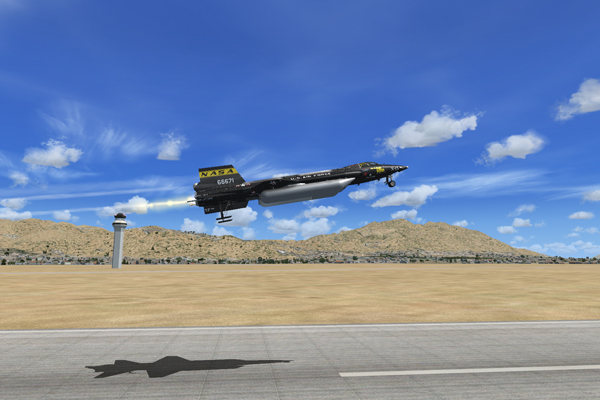
Typical X-15 missions.
In a typical X-15 mission, the rocket airplane is attached under the right wing of a modified B-52 bomber and carried to an altitude of about 45,000 feet. Then, at a scheduled launch time, it is dropped and the pilot fires the airplane's mighty XLR-99 rocket engine to propel the X-15A-2 airplane at several times the speed of sound to high altitude and speed records.
Note: There seems to be no limit to the maximum altitude to be attained by the X-15A-2 in FSX or Prepar3D® (which was limited to 100,000 feet in FS2004). For example, it is now possible to recreate the highest flight of the X-15 program achieved by X-15-3 on August 22, 1963 (354,200 feet). Unfortunately, speed is still limited to approximately Mach 4.65 on all current platforms.
Note: The highest altitude attained by the real X-15A-2 rocket plane was 249,000 feet (August 3, 1966).
Several experiments are conducted during the mission to get as much information as possible about high speed and high altitude flight and about the effects of such flight conditions on the aircraft and on the pilot.
If we exclude the climb to the launch altitude (during captive flight), a typical X-15A-2 mission would last for about 10 minutes, of which about 90 seconds (no external tanks) to 150 seconds (external tanks installed) saw the engine burning.
The procedures presented here are for a typical mission only, and do not cover any specific experimentation, except for the (optional) opening and closing of the skylight hatch [16, fig. 3-2] to expose the star tracker system to the exterior environment.
After the airplane propellants are exhausted or the engine is shut off by the pilot, the X-15 performs reentry into the atmosphere (if on a high altitude mission) and begins a shallow descent before her final glide to a dry lakebed in the high desert of California.
The following is a summary of the real X-15A-2 design mission airspeed-altitude time history:
The X-15A-2 is launched at Mach .82 at 45,000 feet. An immediate engine light is obtained and pull-up to a constant lift coefficient (C) of .65 is executed. This C is maintained until a flight path angle of 36 degrees is obtained, at which time a push-over to zero G is accomplished.
The external tanks are released as soon as practical when empty (Mach 2.1 at 70,000 feet) and the zero-G trajectory is continued on internal propellants to level flight at about 100,000 feet altitude. The airplane is then accelerated at this altitude to burn out at about 8000 fps.
The deceleration is made, maintaining 100,000 feet altitude until C, for maximum UD is reached (C -25) where descent is made maintaining this C.

X-15A-2 SE taking off from the runway at Nellis AFB (Prepar3D® v2 screenshot).
The real X-15 could not take off from the ground. So why can the X-15A-2 SE addon take off from the ground?
Simply because it's fun! This is a simulation after all, and many things that are not permitted in the real world can be done in a simulator. Plus, we thought that our users would like to take off from the ground in their X-15 addon.
This also gives the beginner desktop pilot plenty of time to learn and perform the required preflight procedures while the aircraft in comfortably sitting on the ground instead of falling like a brick in mid-air.
For purists, it is possible to simulate a high altitude launch from a carrier aircraft by using the slew mode commands to reposition the X-15 airplane without flying in real time. A second option is to change the altitude and speed settings in the map window, available from the "World" menu item on the simulator's top menu bar. You can also load one of the high altitude "launch" saved flights that come with the addon.
For simplicity and to allow for easy ground servicing of the X-15A-2 SE addon while you are still learning about this unique aircraft, the following procedures assume a normal takeoff from the ground.
See also: